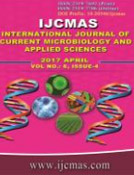


 National Academy of Agricultural Sciences (NAAS)
National Academy of Agricultural Sciences (NAAS)

|
PRINT ISSN : 2319-7692
Online ISSN : 2319-7706 Issues : 12 per year Publisher : Excellent Publishers Email : editorijcmas@gmail.com / submit@ijcmas.com Editor-in-chief: Dr.M.Prakash Index Copernicus ICV 2018: 95.39 NAAS RATING 2020: 5.38 |
The frequent inhabitation of B. cereus in fresh vegetables can critically damage the public health and economics. Fresh vegetables from three sources; Village fields, Supermarkets and Street Vendors were examined for microbiological safety for raw consumption. Among the seven salad vegetables that are integral to daily diet intake were found with high Food MPN count of >100g-1 (42.8-100%), total coliforms >10ml-1 (75.6-98.5%), faecal coliforms >10ml-1 (59.6-91.2%). The highest mean count of B. cereus (4.35 log cfu g-1) was found in carrots sourced from Village fields). The ability of Bacillus isolates to lyse erythrocytes can directly be correlated with the expression of haemolytic enterotoxin. Antibiotic resistance of Bacillus cereus isolates to four or more antibiotics may bud a serious perturbation in treating associated illness. Effectiveness of aminoglycoside, fluoroquinone, tetracycline and glycopeptides during this study could be considered before empirical therapy against B. cereus infections. PCR analysis of nineteen B. cereus isolates showed the presence of haemolytic enterotoxin gene hblA (100%), hblC (73.6%) and hblD (89.4%) and that of non-haemolytic enterotoxin nheA (100%) and nheC (100%). All the isolates were devoid of nheB gene. Their toxigenicity can further increase the risk of illness due to raw consumption of vegetables for which important interventions should be implemented for decontamination.
 |
 |
 |
 |
 |